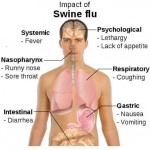Last Updated on June 9, 2025 by Bryan Dastan
Swine flu is caused due to indirect transmission of the H1N1 from the pigs to humans, hence the name swine flu. The virus affects the respiratory system and the symptoms of swine flu are similar to influenza or influenza like illnesses. The symptoms are cough, sore throat, fever, fatigue, headache and chills along with vomiting and diarrhea.
Swine flu virus penetrates deeper into the lungs and could cause complications like pneumonia. Research conducted at the University of Wisconsin, US observed that the swine flu virus causes more severe lung lesions, respiratory damage and inflammation as compared to the human influenza virus. Doctors argue that patients with underlying respiratory complications like asthma should be administered with the swine flu vaccine.
 It starts as a diffuse viral pneumonia and may develop into a more severe respiratory distress syndrome. In extreme cases the virus causes massive inflammation in the lungs. This inflammation leads to fluid build-up in lung tissues and airways which could even result in bleeding of the lung tissues. This condition affects the transfer of oxygen from inhaled air to the blood stream. In the Journal of the American Medical Association researchers report that deprivation of oxygen in the blood leads to shock, organ failure and even death in worst cases.
It starts as a diffuse viral pneumonia and may develop into a more severe respiratory distress syndrome. In extreme cases the virus causes massive inflammation in the lungs. This inflammation leads to fluid build-up in lung tissues and airways which could even result in bleeding of the lung tissues. This condition affects the transfer of oxygen from inhaled air to the blood stream. In the Journal of the American Medical Association researchers report that deprivation of oxygen in the blood leads to shock, organ failure and even death in worst cases.
Physician and epidemiologist Robert Fowler of the University of Toronto observed that lungs are the most visibly affected organs in a case of swine flu. Though patients can breathe, when the lungs are inflamed, the breathing is ineffective. Blood pressure crashes causing disruption in the blood circulation.
This severe form of flu affects the lungs directly even in young healthy people unlike the seasonal flu. The disease continues even in the summer as opposed to the seasonal flu. People aged over 50 are more immune to swine flu as compared to younger people.
This severe respiratory failure is treated using highly specialized care in intensive care units. The treatment is also extremely expensive and the condition has to be completely treated using antiviral flu drugs and a mechanical ventilator to aid breathing.
Even though, the respiratory disease is serious antivirus drugs are extremely effective against the infection.



